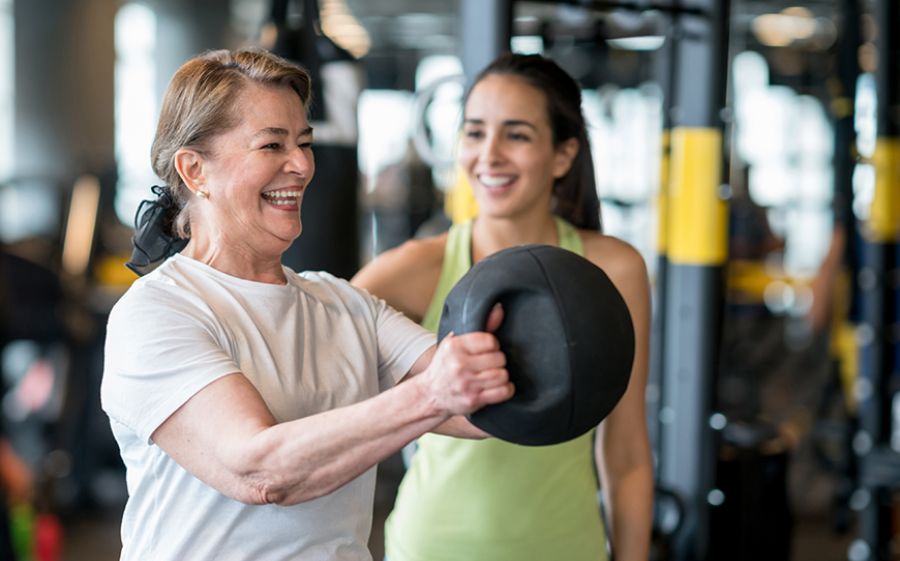
Published: 09/18/2023 - 8:00 AM
Kids are experts at distracting and derailing adults. How many excuses can a child come up with to avoid bedtime at all costs? All that childhood practice makes us experts at avoiding exercise as adults. I’ve written before about how important movement is to my own self-care. My swimming and stretching routines are essential to relieve tension around the inflamed nerves that feed from my spine into my skull, and the endorphins I get from quick cardio workouts can beat back pain when nothing else can. But when I’m in pain, the absolute last thing I want to do is squeeze into some yoga pants and hit the treadmill.
Despite our resistance to exercise, however, doctors say that moving the body is essential to preserving its strength and flexibility. That can be easier said than done, though. When fear stands in the way of exercise, the idea of starting an exercise regimen can cause embarrassment, stress, or fear, even for those who used to relish physical activity.
When Exercise Conflicts With Intuition
What makes exercise so much harder to commit to as we age? If you’re busy juggling work, family obligations, and self-care, you may think that the biggest barrier to working out is finding the time, but that’s not the whole answer. Before we integrate a new positive health behavior into our daily routines, we must integrate it into our thinking. This first step is a crucial one, and it can easily be hindered by our thinking. That’s because every time we consider a new behavior or treatment plan, we intuitively check it against what we know — or think we know — about the body.
Imagine, for instance, that on the third day of a bout with the common cold, you wake up with a very stuffy nose. I bet I can guess what you’d do: reach for a tissue! When your body sends the message that your nose is congested, your mind concludes that it needs to be cleared out; you blow your nose, and hope to restore normal respiration. It turns out it’s not what your poor nose needs! Stuffy noses are caused by inflammation of the nasal passages, not physical blockages. The harder you blow a stuffy nose, the stuffier it will get. Knowing that won’t stop most of us from reaching for the tissues, though. It’s much easier to accept seemingly intuitive health advice — even if it’s wrong — because it doesn’t set off our mind’s self-protective alarm bells.
Getting Past What We Think is Best
When your loved ones are feeling anxiety, discomfort, and fatigue, those feelings set off lots of alarm bells telling them to stay still and rest to conserve energy and avoid further harm. If a health care provider tells them to exercise, it can fly in the face of everything they think they know about their bodies. It’s not easy to be told that you must do something that you feel will hurt you.
To support the older adults in your life in starting an exercise regimen as part of their daily lives, you’re going to have to help them overcome the stress and anxiety triggered by the thought of doing something new and intimidating.
- Get the doctor’s approval. Before your loved one begins any plan for physical activity, make sure to check with the patient’s primary care physician and any specialists to ensure that it’s safe. Some medical conditions and injuries can necessitate modifications to some exercise moves. As a bonus, having the doctor’s support means the advice is “doctor’s orders” — not just nagging!
- Ask a trusted health care provider about physical therapy. A skilled physical therapist is a great partner in health, whether you’re just starting to strengthen the body, or trying to maintain a certain activity level. A physical therapist will be able to develop a training program, answer any questions, and — best of all — distract from any worries and ease fears. They are very familiar with working with resistant patients.
- Start slowly. Recognize that for the sake of both mind and body, a slow increase in physical activity is always best. A few laps around the living room over the course of the day can also add up to a walk around the block pretty quickly. Strength will build slowly, and confidence will increase. As patients feel small gains, their thinking about exercise will become more positive.
- Incorporate incentives and feel-good moves. Plan to enjoy a favorite activity for after physical activity, whether that’s a visit to the local library, a manicure, or a visit from a friend. Massages and stretches are great incentives. Make sure your loved one eats a nutritious and delicious meal, too! Associating these positive things with physical activity will help make it easier to believe that exercise is good for the body.
- Give it time. Allow for flexibility when planning out a new exercise plan. Life will cause interruptions, and bodies can plateau temporarily on their way to getting stronger. Especially for those living with illness, scheduling far in advance might be difficult. Meet the body where it is, and celebrate small accomplishments.
Also, don’t forget to practice what you preach! Regular physical activity is one of the keys to a longer, healthier life for all of us.
This content is not intended to be a substitute for professional medical advice, diagnosis, or treatment. The information on this web site is for general information purposes only. Always seek the advice of your physician or health care provider on any matters relating to your health.
Original post by Mara Hughes from Independence Blue Cross.